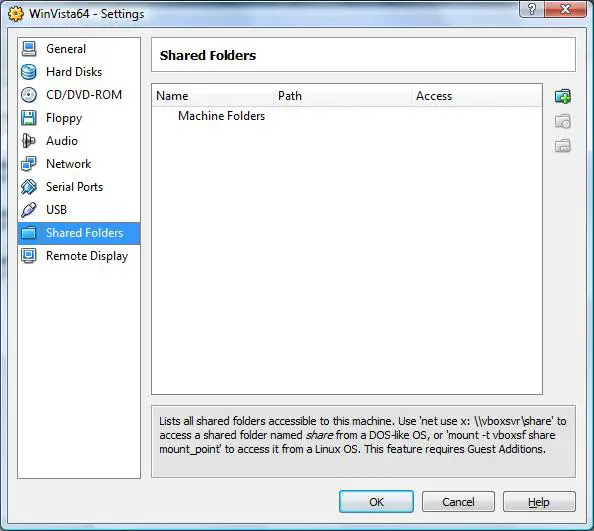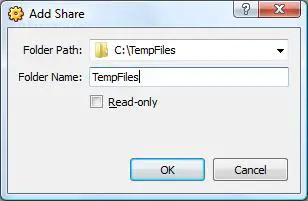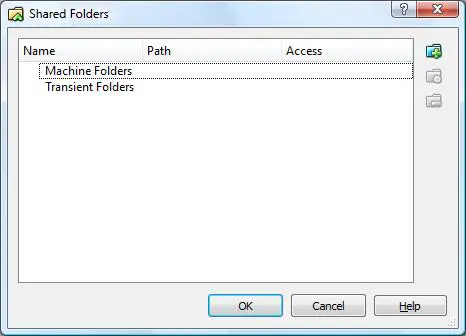VirtualBox Shared Folders
One of the most impressive features of VirtualBox, and virtualization in general, is the ability to run guest operating systems that are completely incompatible with the host operating system. A common requirement in virtualized environments is the sharing of files between the host and guest operating systems. Most virtualization technologies leave this task to the system administrator and, whilst this can be straight forward when the guest virtual machines and host are running the same operating system, it can be become complex when different operating systems are involved. For example, sharing files between a Windows host and a Linux guest involves the installation and configuration of Samba technology and correctly configured network connectivity between the guest and host.
Fortunately, VirtualBox makes the sharing of files between guests and a host system easy through a feature known as Shared Folders.
An Overview of VirtualBox Folder Sharing
VirtualBox Shared Folders allow files residing on the host system to be accessed by guest operating systems running in virtual machines. In addition, assuming adequate permissions are granted on the shared folder, the guest is also able to transfer files onto the host by copying them into the shared folder.
VirtualBox folder sharing is currently only supported for Windows and Linux guests. Shared folders are not supported on virtual machines running Windows 3.1, Windows 95, Windows Me or Windows 98 guests.
Shared folders can be configured such that they are persistent (in other words the share is still configured even if the guest is restarted) or transient (such that they a lost after the virtual machine is shutdown or rebooted). Shared folders may also be declared as read-only to prevent the guest operating system from writing to the host folder.
The creation of a shared folder involves selecting the folder on the host system which is be to shared, assigning a share name and choosing whether the folder is to be read-only and transient or permanent.
VirtualBox Shared Folders on inactive virtual machines are configured through the Settings dialog. This dialog is accessed by selecting the desired virtual machine from the list and clicking the Settings button in the toolbar. Once the settings dialog is visible, click on the Shared Folders entry in the right hand pane to display the following screen:
To add a new shared folder, click on the add folder button (the top button containing an icon of a folder with a green plus sign) and select a folder on the host system to be shared with the selected guest. To browse for a specific folder, click the down arrow in the Folder Path text box and select Other... from the drop down menu. Once a suitable folder has been selected, enter a name for the share in the Folder Name field. If the guest operating system is to be denied write access to the folder, ensure that the Read-only check box is selected before clicking the OK button to create the share:
Once the shared folder has been configured, start the virtual machine to access the folder. The mechanism for accessing the folder from within the guest will depend on the type of guest operating system running in the virtual machine, details of which are covered later in this chapter.
Shared folders may be configured on a running virtual machine by selecting the Devices->Shared Folders.. menu of the virtual machine window. Once selected, this will display the Shared Folders dialog as illustrated below:
To add a new shared folder, click on the add folder button (the top button containing an icon of a folder with a green plus sign) and select a folder on the host system to be shared with the selected guest. To browse for a specific folder, click the down arrow in the Folder Path text box and select Other... from the drop down menu. Once a suitable folder has been selected, enter a name for the share in the Folder Name field. If the guest operating system is to be denied write access to the folder, ensure that the Read-only check box is selected.
If the share is to be transient (in other words it will not be restored when the virtual machine is restarted) leave the Permanent check box unselected before clicking the OK button to create the share.
VirtualBox shared folders can be created from the command prompt using the VBoxManage command-line tool on the host. VBoxManage is installed by default on Windows hosts in C:\Program Files\Sun\xVM VirtualBox and in /opt/VirtualBox on Linux.
The syntax to create a shared folder using VBoxManage is as follows:
- VBoxManage sharedfolder add "<virtual machine>" -name "<share name>" -hostpath "<host path>"
where <virtual machine> is the name of the virtual machine to which the shared folder is to made available, <share name> is the name to be assigned to the share and <host path> is the path to the folder on the host file system. For example to make C:\Temp on the host system a shared folder named MyShare available to a virtual machine named Fedora 10, the following command would need to be executed:
vboxmanage sharedfolder add "Fedora 10" -name "MyShare" -hostpath "C:\Temp" VirtualBox Command Line Management Interface Version 2.1.4 (C) 2005-2009 Sun Microsystems, Inc. All rights reserved.
Note that the target virtual machine must be power off before the command is executed. Failure to meet this requirement will result in output similar to the following:
[!] FAILED calling a->virtualBox->OpenSession(a->session, uuid) at line 4233!
[!] Primary RC = VBOX_E_INVALID_OBJECT_STATE (0x80BB0007) - Current object stat
e prohibits operation
[!] Full error info present: true , basic error info present: true
[!] Result Code = VBOX_E_INVALID_OBJECT_STATE (0x80BB0007) - Current object stat
e prohibits operation
[!] Text = A session for the machine 'Fedora 10' is currently open (or be
ing closed)
[!] Component = Machine, Interface: IMachine, {ea6fb7ea-1993-4642-b113-f29eb39
e0df0}
[!] Callee = IVirtualBox, {339abca2-f47a-4302-87f5-7bc324e6bbde}
To resolve this problem, power off the virtual machine and repeat the command.
The previously created shared folder may be removed using the VBoxManage tool as follows:
C:\Program Files\Sun\xVM VirtualBox>vboxmanage sharedfolder remove "Fedora 10" -name "MyShare" VirtualBox Command Line Management Interface Version 2.1.4 (C) 2005-2009 Sun Microsystems, Inc. All rights reserved.
On Windows guests, the shared folder should appear as a standard Windows network share listed under VirtualBox Shared Folders, accessible from the Network option in the Start menu. If the shared folder is not visible within the Network window (as can sometime be the case), it may be mapped to a disk drive in a command prompt window by issuing the following command:
- net use <drive>: \\vboxsvr\<share name>
where <drive>: represents the drive letter to be mapped to the shared folder and <share name>> is the name assigned to the shared folder during the creation process outlined above. For example, to map a shared folder named TempFiles to the S: drive on the guest operating system:
C:\Users\vbox> net use s: \\vboxsrv\TempFiles The command completed successfully.
Shared Folders are accessed on Linux guests by mounting the folder at a suitable mount point using the mount command. This can either be an existing directory, or a new directory may be created specifically for this purpose. The syntax to perform the mount (which must be performed as super-user or using the sudo command) is as follows:
- mount -t vboxsf [-o MOUNT OPTIONS] ShareName MountPoint
where [-o MOUNT OPTIONS] represents any optional directives to the mount command, ShareName is the name assigned to shared folder when it was created and MountPoint is the path to the directory on the guest where the shared folder is to be mounted. For example, to mount a shared folder named TempFiles using /tmp/mnt as the mount point:
mkdir /tmp/mnt mount -t vboxsf TempFiles /tmp/mnt
Once this command has been executed, the files in the host folder will be accessible in /tmp/mnt.




